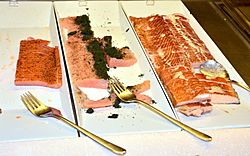Gravlax facts for kids

Salmon dishes: gravlax in the middle, cold-smoked on the left and warm-smoked on the right
|
|
| Alternative names | Gravad lax, grav(ad)laks, gravad laks |
|---|---|
| Course | Hors d'oeuvre |
| Place of origin | Nordic countries |
| Main ingredients | salmon, salt, sugar, dill/spruce |

Gravlax is a special dish from the Nordic countries in Northern Europe. It is made from salmon that has been "cured." Curing means preserving food using ingredients like salt and sugar.
For gravlax, salmon is covered with salt, sugar, and fresh dill or spruce twigs. Sometimes, it is also lightly smoked. Gravlax is usually served as an appetizer, which is a small dish eaten before the main meal. It is sliced very thinly. People often eat it with a special dill and mustard sauce called hovmästarsås. You can enjoy it on bread or with boiled potatoes.
What Does Gravlax Mean?
The name gravlax comes from old Nordic words. Grav means "to dig" or "to cure fish." Lax means "salmon." So, gravlax basically means "buried salmon" or "cured salmon."
A Look Back: How Gravlax Was Made
Hundreds of years ago, during the Middle Ages, fishermen made gravlax in a unique way. They would salt the salmon and then bury it in the sand. This helped to preserve the fish. It was a simple way to keep food fresh before refrigerators existed!
Today, gravlax is made differently. We no longer bury the fish to ferment it. Instead, the salmon is covered in a dry mix of salt, sugar, and dill. This mix is called a "marinade." The salmon then sits for a few days. During this time, the salt and sugar pull moisture out of the fish. This process helps to cure the salmon and gives it its special flavor and texture. This same method can be used for other fatty fish, but salmon is the most popular choice.
See also
 In Spanish: Gravlax para niños
In Spanish: Gravlax para niños

